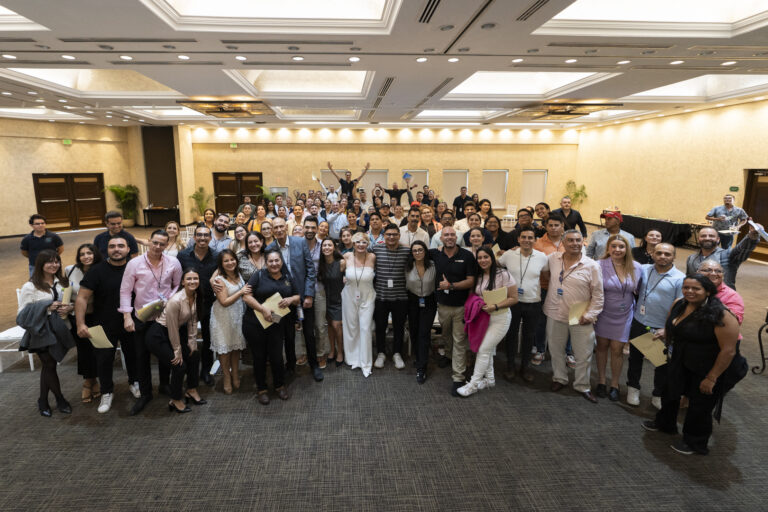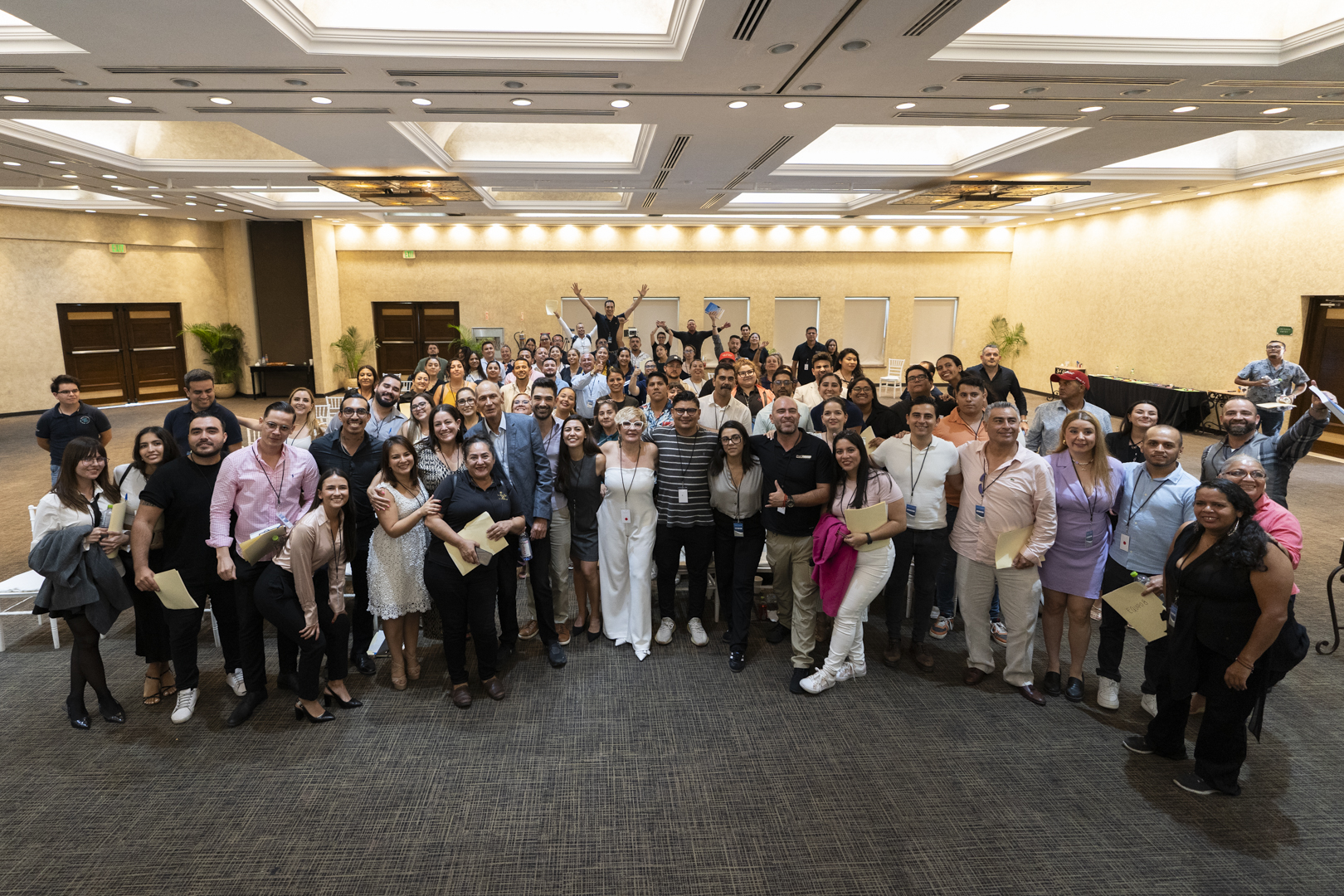Insights from Leadership Books
Cami Nelson
agosto 26, 2024

Mastering Leadership: A Deep Dive into «Make It Happen»
Leadership has always been a topic of immense interest and research. The quest to understand what characterizes a great leader has led to the creation of numerous books, articles, and studies. Among them, «Make It Happen» by Robert Kistner, which stands out as a seminal leadership book that offers deep insight into the essence of effective leadership. This blog delves into the complexities of leadership as expressed by Kistner, integrating his principles with broader leadership theories and practical applications.
«Make It Happen» by Robert Kistner is more than just a leadership manual; It is a roadmap to transform potential into tangible success. It stands out as a fundamental work that offers a deep insight into the essence of effective leadership. Kistner’s approach is comprehensive and practical, making him a valuable resource for aspiring and established leaders. Unlike many books on leadership that focus strictly on specific aspects, Kistner’s work provides a holistic view that integrates vision, strategy, empowerment, communication, resilience, ethics, and continuous learning.
This blog delves into the intricacies of leadership as articulated by Kistner, integrating his principles with broader leadership theories and practical applications. By exploring the core themes of «Make It Happen,» we aim to provide a thorough understanding of what it takes to be a successful leader in today’s complex and rapidly changing environment. We will examine how Kistner’s principles align with well-established leadership theories, such as transformational leadership, servant leadership, situational leadership, and emotional intelligence, and how these principles can be applied to real-world scenarios.
The importance of leadership in today’s world
Leadership is more critical today than ever. In a world characterized by rapid technological advances, globalization and unprecedented challenges, effective leadership can make the difference between success and failure for organizations. Leaders are not only responsible for guiding their teams toward achieving goals, but also for navigating through crises, fostering innovation, and building resilient cultures.
The increasing complexity of the modern workplace requires leaders who can think strategically, communicate effectively and inspire their teams. Additionally, ethical considerations and corporate social responsibility have become integral to leadership, demanding leaders who can balance profits with principles.
Robert Kistner’s assertion, «Everything is changing; we have to change with it,» underscores the relentless pace of change in today’s world. This rapid transformation has not only reshaped industries and markets but has also spurred a fundamental shift in how business leaders operate. The digital age has transformed the way leaders connect with their teams and stakeholders. Virtual leadership skills are now essential, allowing leaders to manage remote teams, leverage digital tools for productivity and communication, and foster a sense of belonging and motivation among dispersed employees.
Success through Engagement in Leadership:
Robert Kistner describes leadership by engagement: “In your career path, you create enthusiasm. That’s been the biggest key to our success over the years.” Leaders who embody a mindset of perpetual learning not only expand their own knowledge and skills but also inspire those they lead to pursue similar paths of growth. By demonstrating a genuine enthusiasm for learning and personal development, these leaders create a culture where curiosity, innovation, and adaptability thrive.
When leaders prioritize continuous learning, they signal to their teams that staying abreast of industry trends, acquiring new skills, and challenging assumptions are not just encouraged but essential for staying competitive and relevant. This attitude of lifelong learning encourages team members to embrace change, take initiative, and contribute fresh ideas that drive organizational progress.
And Bob knows that there’s no better way to create engagement on a team than to lead by example. Because actions speak louder than anything else. A regular boss will ask you to do stuff, but a true leader will find the way to get the best of his / her team and always motivate them to go for more.
Visionary Thinking: The Foundation of Leadership
Visionary thinking is the cornerstone of Kistner’s leadership philosophy. A leader without a vision is like a ship without a compass, adrift in a sea of uncertainty. Vision provides not just direction but also a compelling purpose, igniting passion and commitment within both the leader and their team. Kistner emphasizes that visionary thinking goes beyond mere foresight; it involves looking beyond the present circumstances and imagining what could be, envisioning possibilities that others might overlook.
At its core, visionary thinking requires leaders to transcend the immediate challenges and envision a future that is both aspirational and achievable. It involves anticipating trends, understanding emerging technologies, and predicting market shifts, all while staying true to core values and principles. For Kistner, this forward-thinking approach isn’t just about setting goals; it’s about creating a roadmap that inspires innovation and fosters resilience in the face of adversity.
Additionally, visionary leaders understand the importance of communicating their vision effectively. They articulate a clear and compelling picture of the future, aligning their team’s efforts with strategic objectives. By sharing their vision, leaders cultivate buy-in and enthusiasm among stakeholders, empowering people to contribute creatively and collaboratively toward common goals.
Difference between leader and manager:
The distinction between a leader and a manager lies in their approaches, impact, and relationship with their teams. A manager typically occupies a position of formal authority within an organization, relying on hierarchical power and organizational structure to influence his or her team. Managers focus primarily on supervising tasks and ensuring compliance with established objectives, guiding employees through directives and decisions based on formal authority.
In contrast, a leader transcends formal authority and exerts influence through example, inspiration, and emotional connection with her team. A leader not only delegates tasks but also fosters an environment of trust and collaboration where team members feel motivated and empowered to contribute to overall success. Leaders are not limited to task management; They also prioritize the personal and professional development of their followers, with the goal of fostering talent and building meaningful relationships within the team.
In terms of impact, a manager can achieve short-term results through directive actions and disciplinary actions, while a leader focuses on long-term growth for both the team and the organization. Leaders cultivate a culture of innovation, continuous learning, and adaptability in response to evolving business challenges.
Leadership styles: Leadership styles refer to specific approaches that leaders take to influence their teams and achieve organizational goals effectively. In the realm of project management and business, these styles can vary widely, reflecting the diversity of the work environment, the unique needs of each project, and the characteristics and dynamics of the team. Understanding these styles is crucial for any leader aiming to optimize team performance and drive success.
The right leadership style can make a significant difference in how a team operates and how well it meets its objectives. Different situations may call for different leadership approaches. For instance, a high-stress, deadline-driven project might benefit from a more directive leadership style, while a creative, innovation-focused environment might thrive under a more participative or laissez-faire approach. Leaders need to be adaptable, recognizing when to employ various styles to best support their team’s needs and the project’s goals.
So, here are several commonly recognized leadership styles that leaders adopt to influence their teams and achieve organizational goals effectively:
- Autocratic leadership:
Autocratic leadership is characterized by leaders who exercise exclusive authority to make decisions without seeking input or consensus from their team members. This style is often effective in environments where quick, decisive action is necessary to address crises or meet urgent deadlines. By eliminating the need for extensive consultation, autocratic leaders can speed up decision-making processes and ensure that action is taken promptly.
However, while autocratic leadership can bring clarity and efficiency in certain situations, its long-term implications can pose challenges. A major drawback is its potential to stimulate creativity and innovation within the team. When team members are not involved in decision-making processes, they may feel disconnected or undervalued, which over time leads to decreased morale and motivation. This lack of articipation can also hinder the development of new ideas and solutions that could benefit the organization in the long term.
Additionally, the authoritarian nature of autocratic leadership can create an environment of dependency, where team members rely heavily on the leader for direction without developing their problem-solving skills or taking initiative. This dependency can limit the team’s ability to adapt to changing circumstances independently, which can become a drawback in dynamic and unpredictable business environments.
- Democratic Leadership:
Democratic leadership is characterized by leaders who actively involve their team members in the decision-making process. This style contrasts with autocratic leadership by prioritizing inclusion, collaboration, and empowerment of team members. Leaders who practice democratic leadership value their team’s diverse perspectives and experience, encourage open communication, and solicit input on decisions that impact the group.
Bob Kistner exemplifies democratic leadership by fostering an inclusive environment where team members are encouraged to contribute ideas and participate in decision-making processes. Throughout his career in timeshare sales, Bob implemented regular team meetings where everyone had a voice, from frontline salespeople to senior managers. He believed that diverse perspectives enriched strategies and fostered a culture of innovation. By valuing each team member’s input, Bob not only empowered his employees but also cultivated a strong sense of ownership and commitment to shared goals.
Additionally, democratic leadership promotes innovation and creativity by harnessing the collective wisdom of the team. Different points of view and experiences can lead to more comprehensive problem-solving and decision-making processes, as ideas are critically evaluated and refined through constructive dialogue. This collaborative environment fosters a culture of continuous improvement and adaptation, where the organization can respond effectively to challenges and take advantage of growth opportunities.
- Transformational Leadership
Transformational Leadership is a powerful approach where leaders go beyond managing day-to-day tasks and instead focus on inspiring profound change and growth within their teams and organizations. At its core, transformational leadership revolves around visionary leadership and the ability to inspire others through a compelling and inclusive vision for the future.
Central to transformational leadership is the leader’s capacity to articulate a clear and inspiring vision that resonates with the values and aspirations of their team members. This vision serves as a guiding beacon, aligning individual efforts with collective goals and fostering a sense of purpose and direction within the organization. By communicating this vision effectively, transformational leaders empower their teams to see beyond immediate challenges and work towards a shared, aspirational future.
When asked how he managed to transition from traditional sales methods to navigating a business environment dominated by the internet, Bob Kistner exemplifies transformational leadership. He embraced change by recognizing the potential of digital platforms to revolutionize the timeshare industry. Bob led by example, embracing new technologies himself and encouraging his team to adapt and innovate. By championing a vision of leveraging online marketing and e-commerce, Bob transformed his approach, ensuring the company remained competitive and relevant in a rapidly evolving market.
- Transactional Leadership:
Transactional Leadership is a leadership style characterized by a transactional exchange between the leader and their followers. In this approach, the leader establishes clear expectations, sets goals, and defines roles and responsibilities for team members. The relationship is based on a system of rewards and punishments, where individuals are rewarded for achieving specified objectives and face consequences for failing to meet them.
One of the key strengths of transactional leadership lies in its ability to maintain discipline and uphold standards within the organization. By clearly outlining expectations and providing tangible rewards for successful performance, leaders using this approach can motivate team members to meet targets and fulfill responsibilities effectively. This structured framework helps ensure that tasks are completed on time and according to established guidelines, promoting efficiency and accountability within the team.
In the dynamic and fast-paced environment of internet-driven business, Bob Kistner employs transactional leadership to ensure his team’s success. He sets clear goals and expectations, establishing performance metrics and incentives tied to measurable results. Bob’s approach involves providing timely feedback and recognition for achievements, motivating his team to excel. By creating a structured framework of rewards and consequences based on performance, Bob fosters a high-performance culture where individuals are driven to meet and exceed expectations in pursuit of organizational success.
- Situational Leadership:
Situational Leadership is a flexible and adaptive approach where leaders adjust their style to suit the specific circumstances and needs of their team. Unlike fixed leadership styles that remain consistent regardless of the situation, situational leaders recognize that different situations require different approaches to effectively guide and support their team members.
At the core of situational leadership is the leader’s ability to assess and understand the current context, including factors such as the complexity of tasks, team dynamics, individual skills and experience levels, and the urgency of deadlines. Based on this assessment, situational leaders can determine the most appropriate leadership style or approach to maximize team performance and achieve organizational objectives.
One key aspect of situational leadership is its focus on providing the right level of direction and support to team members based on their readiness or competence to perform a task. Situational leaders may adopt different leadership behaviors, ranging from more directive (providing clear instructions and guidance) to more supportive (offering encouragement and resources) depending on the developmental level of their team members.
As team members gained confidence and proficiency, Bob gradually delegated more responsibilities, empowering them to make independent decisions. His ability to assess and adapt his leadership style based on the evolving needs of his team contributed to their growth and success.
- Coaching Leadership
And finally we have Leadership Coaching, which is a style characterized by leaders who prioritize the individual and professional development of their team members. Unlike traditional top-down approaches, coaching leaders act as mentors and facilitators, guiding their team through personalized support and encouragement to foster self-confidence, autonomy and continuous learning.
At the heart of leadership coaching is a belief in the potential of each team member and the importance of investing in their growth. These leaders take a proactive role in understanding the strengths, weaknesses, aspirations and development needs of their team members. Through regular one-on-one interactions and constructive feedback, coaching leaders provide guidance tailored to each individual’s growth trajectory.
Throughout his tenure in timeshare sales, Bob invested significant time and effort into mentoring and coaching individuals at all levels of the organization. For example, Bob would shadow sales calls, offering constructive advice on enhancing communication skills and refining sales techniques.
Developing Emotional Intelligence in Leadership
One of the most important aspects touched on in most leadership and business books is emotional intelligence, which is a critical component of effective leadership. Leaders with high emotional intelligence are experts at recognizing and managing their own emotions, as well as understanding and influencing the emotions of others. This ability is crucial to fostering a positive work environment, resolving conflict, and leading teams through change.
Strategies for Developing Emotional Intelligence
1. Self-Reflection: Leaders can develop self-awareness through regular self-reflection. Keeping a journal, seeking feedback, and contemplating their responses to different situations can help leaders gain a deeper understanding of their emotional triggers and patterns.
2. Mindfulness Practices: Mindfulness techniques, such as meditation and deep breathing exercises, can help leaders improve their self-regulation by increasing their ability to stay present and manage stress.
3. Goal Setting: Setting personal and professional goals aligned with their values can help leaders stay motivated. Regularly reviewing and adjusting these goals ensures they remain relevant and challenging.
4. Active Listening: To enhance empathy, leaders should practice active listening. This involves fully concentrating, understanding, responding, and then remembering what is being said. Leaders can show they value their team members’ input by asking open-ended questions and providing feedback.
5. Communication Training: Developing social skills can be supported by training in areas such as public speaking, negotiation, and conflict resolution. Role-playing scenarios and receiving constructive feedback can also be beneficial.
In reflecting on his journey, Bob Kistner shares profound insights into managing failure throughout his career. He acknowledges that setbacks are inevitable but emphasizes that true resilience lies in how we respond to them. ‘Failure is not fatal,’ Bob asserts, drawing from his experiences navigating challenges in the competitive world of timeshare sales and management. ‘It’s about learning from mistakes, adapting strategies, and forging ahead with renewed determination.’ His approach underscores the importance of leveraging setbacks as opportunities for growth and innovation, a testament to his enduring leadership philosophy.
The Impact of Emotional Intelligence on Leadership
Fostering a Positive Work Environment: Leaders with high emotional intelligence create a positive work environment by promoting open communication, trust, and mutual respect. Their ability to manage their own emotions and understand others’ emotions helps prevent and resolve conflicts, leading to a more harmonious workplace.
Enhancing Team Performance: Emotional intelligence enables leaders to motivate and inspire their teams. By understanding their team members’ emotional needs and aspirations, leaders can provide appropriate support and encouragement, boosting morale and productivity.
Navigating Change Effectively: Change is a constant in the business world, and emotionally intelligent leaders are better equipped to guide their teams through transitions. Their ability to manage their own stress and help their team members cope with uncertainty and fear ensures smoother and more successful change initiatives.
Building Stronger Relationships: Leaders who demonstrate empathy and strong social skills build stronger relationships with their team members, peers, and stakeholders. These relationships are built on trust and mutual respect, which are essential for effective collaboration and achieving organizational goals.
HTM – The Key in Leadership Books to Building a Successful Team
Imagine a team that not only performs well but is also motivated and eager to learn. Sounds great, right? This is where the HTM strategy that Robert Kistner mentions in his leadership book “Make It Happen” comes into play.
So how can you, as a leader, implement this in your organization?
Choose the best people: Have you ever been in a position where you had to hire someone? It’s a crucial task, right? When you have control over hiring, it is essential to choose people who not only have skills but are also willing to participate in training and come away motivated. Robert Kistner’s advice for leaders is invaluable here. He advocates the HTM strategy: “Hire, Train and Motivate.” Let’s discuss how this can work for you.
Hire the right people: Imagine you are creating a team from scratch. You wouldn’t choose just anyone, would you? You would want the best fit. Kistner’s first step, «Hire,» emphasizes selecting people who are perfect for the job. Look beyond written grades. Consider your attitude, cultural fit, and growth potential. The right people are those who align with your company’s values and have the ability to learn and adapt.
Train for success: Once you’ve hired the right people, what’s next? Training! Think about the last time you started a new job or role. The training he received was crucial to his success. This is the second step in Kistner’s HTM strategy. Give your team the tools and training they need to excel. Remember, training is not a one-time event but an ongoing process. Continuous learning keeps your team up to date and efficient.
Motivate your team: Now, let’s talk about motivation. Even the best training won’t help if your team isn’t motivated. This is the final piece of the HTM strategy. Motivated employees are engaged, productive, and committed to the success of the organization. Leadership coaching is key here. Create the necessary motivation by helping people understand their strengths, set goals and develop confidence. A motivated team is a high-performing team.
How to implement HTM in your organization
So, how can you bring HTM into your organization? Before diving into the practical steps, it’s essential to understand that HTM is not a one-size-fits-all solution. Each organization is unique, with its own culture, values, and goals. Implementing HTM requires a tailored approach that aligns with your specific needs and circumstances. Here’s a roadmap to help you integrate HTM effectively:
Hiring:
* Define the skills and attributes required for each role.
* Use behavioral interview techniques to assess cultural fit and growth potential.
* Involve team members in the hiring process to ensure a good fit.
Training:
* Develop a comprehensive onboarding program for new employees.
* Offer regular training sessions and workshops.
* Encourage cross training to build a versatile team.
Motivating:
* Provide feedback and recognition regularly.
* Set clear goals and celebrate achievements.
* Invest in leadership coaching for personal and professional development.
Recommended Books on Leadership:
Leadership literature offers a rich source of knowledge and perspectives that can benefit leaders at any stage of their professional development. Below we will present some recommended books in addition to Make It Happen by Robert Kistner, which address various facets of leadership:
«The 21 Irrefutable Laws of Leadership: Follow Them and People
Will Follow You» by John C. Maxwell
In this seminal work, John C. Maxwell presents 21 universal laws of leadership that are essential for anyone looking to improve their influence, communication, and team-building skills. Maxwell’s laws are easy to understand and practical, providing actionable insights that leaders can apply immediately. From the Law of Influence, which states that «leadership is not about titles, positions, or flowcharts. It is about one life influencing another,» to the Law of Navigation, which emphasizes the importance of a leader’s vision and planning, Maxwell’s principles are timeless and applicable across various leadership scenarios.
«Think and Grow Rich» by Napoleon Hill
Originally published in 1937, this classic remains one of the most influential books in the realm of personal development and success literature. Napoleon Hill’s «Think and Grow Rich» delves into the philosophy of success, emphasizing the power of thoughts, persistence, and a definitive purpose. While not a traditional leadership book, its principles are crucial for leaders who aspire to achieve financial success and personal fulfillment. Hill’s exploration of the psychology of success and his practical advice on goal setting, decision making, and maintaining a positive mental attitude have inspired generations of readers.
«Leaders Eat Last: Why Some Teams Pull Together and Others Don’t» by Simon Sinek
Simon Sinek explores the concept of leadership from a biological and anthropological perspective, arguing that the most successful teams are those where leaders prioritize the well-being of their team members. In «Leaders Eat Last,» Sinek discusses how great leaders create a «Circle of Safety» that fosters trust, collaboration, and commitment among team members. He uses real-world examples from the military, business, and government to illustrate how leaders can build environments where people feel valued and motivated to contribute their best efforts.
«Dare to Lead: Brave Work. Tough Conversations. Whole Hearts.» by Brené Brown
Brené Brown’s «Dare to Lead» focuses on the importance of vulnerability, courage, and empathy in leadership. Brown argues that great leaders are not those who project invulnerability but those who are willing to show up authentically and lead with a whole heart. The book offers actionable strategies for developing courageous leadership, fostering trust, and building resilient, innovative teams. Brown’s insights are particularly relevant for leaders looking to create inclusive, supportive, and adaptive organizational cultures.
«Drive: The Surprising Truth About What Motivates Us» by Daniel H. Pink
Daniel Pink’s «Drive» explores the science of motivation and its implications for leadership. Pink challenges traditional notions of motivation, which often rely on external rewards and punishments, and presents a compelling case for the power of intrinsic motivation. He identifies three key elements that drive high performance and satisfaction: autonomy, mastery, and purpose. Leaders can use these insights to create environments where team members feel empowered, engaged, and driven to achieve their best work.
These books offer valuable insights into different styles and aspects of leadership, from building strong organizational cultures to developing key personal skills such as effective communication, decision making, and change management. Reading these books can provide leaders with practical tools and theoretical knowledge that they can apply to strengthen their impact and success in leadership roles.
We hope this information has been valuable and helpful for you. Exploring these leadership books can provide you with a wealth of knowledge and practical insights that can enhance your leadership skills and effectiveness. Whether you are looking to build stronger teams, foster a positive organizational culture, or develop your personal leadership capabilities, these resources offer guidance and inspiration.
In the vast field of leadership, books have been essential in providing theories, strategies, and practical examples that help leaders develop their skills and lead their organizations to success. Among these, Robert Kistner’s «Make It Happen» stands out as a seminal work that integrates key leadership principles with practical applications, offering a holistic approach that is both accessible and insightful.
Leadership books, like «Make It Happen,» play a crucial role in the continued development of leaders at all levels. These books not only provide theories and models for understanding leadership, but also offer concrete strategies for meeting challenges and seizing opportunities. Kistner, through his work, has managed to synthesize years of leadership experience into a framework that is both inspiring and practical. This approach is vital because, in today’s business environment, leaders must be able to transform theory into tangible action.
In addition to «Make It Happen,» exploring other recommended books such as «The 21 Irrefutable Laws of Leadership,» «Think and Grow Rich,» «Leaders Eat Last,» «Dare to Lead,» and «Drive» can significantly broaden your understanding and approach to leadership. These works collectively cover essential areas like team-building, personal growth, organizational culture, and motivation.
Remember, leadership is a continuous process of learning, applying, and evolving. Stay curious, stay motivated, and keep leading with purpose. Embrace the journey of self-improvement and organizational excellence by delving into these insightful resources.
Thank you for reading! We are thrilled to be part of your leadership journey and look forward to seeing the positive impact you will make in your teams and organizations.
Latest Blog
Contact Info

Empowering leaders with actionable strategies for transformative leadership
Navigation
- Home
- Order your book
Copyright © 2024. All rights reserved




